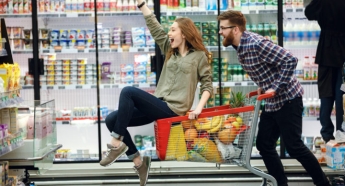With the first semester of 2025 almost behind us, we are taking a look at the trends that are shaping packaging. A new generation of consumers are making their expectations clear, as the link between packaging, the environment and health becomes more and more evident.
1 Sustainability as identity
These days sustainable packaging is no longer an option - it is the norm. Both brands and consumers are consistently choosing green alternatives. Eight out of ten Belgians want to protect the environment by producing less waste. Less packaging, reusable packaging and packaging suitable for recycling are all part of the solution. People are increasingly making a statement through their purchasing behaviour. The rules on packaging are being rewritten with sustainability and authenticity as main characteristics. Now 60% of the public want to know what companies are doing to shrink the carbon footprint of their packaging. For companies, the sustainability of their packaging is therefore an integral part of their ability to stand out as a brand.
2 A bigger place for reuse
By 2040 the share of packaging waste in Europe needs to fall by 15% per person. Reusable and refillable alternatives seem to be obvious ways of addressing the sustainability challenges of single-use packaging, but the process is not straightforward. Progress is being made in e-commerce and beverage packaging, but a lot remains to be done in other sectors. Consumers are expecting companies to take the lead in making the sustainable choice the easy choice. The same is true when it comes to reuse. Here the main barriers to adoption are perceived inconvenience, concerns over hygiene and higher prices. For systems to work on a large scale, harmonisation and collaboration will be needed throughout the value chain.

3 Health concerns
The majority of Belgians (82%) feel that climate (change) is having a negative impact on their daily lives and health. When people think about the causes of this and what individuals can do about it, they tend to blame consumerism (overconsumption) and (plastic) waste. At the same time, there are growing concerns about microplastics and chemical substances such as PFAS that we are ingesting through the packaging around our food. Inks, adhesives and barrier materials in packaging are increasingly viewed with suspicion. In many cases not enough is known about their long-term impacts. Clearly the way we live and consume products is a cause of concern. Paradoxically, however, that is not yet translating into changes in our purchasing behaviour. Only half of consumers factor the sustainability or non-sustainability of packaging into their decision to purchase a product.
4 The big material shift?
The relationship between consumers and packaging has changed, but now packaging itself is changing too. The quantity of household packaging marketed by Fost Plus members in 2023 has fallen to levels last seen before 2010. Inflation certainly plays a part in this, but packaging optimisation is a factor too: packaging is becoming smaller and lighter. In 2016 the majority (66%) of metal drink cans were still made from ferrous metal (steel), but in 2023 this percentage had fallen to 48% in favour of lighter aluminium. Elsewhere, the Packaging and Packaging Waste Regulation is expected to further accelerate the shift to paper-based packaging. There are strict limits on single-use plastics, but these rules do not apply to paper and cardboard. Strict criteria on the recyclability of paper and cardboard and clarity on the uses for which they are suited will be needed to counter claims of greenwashing.
5 Creating little treats
There are no trends without trendsetters, and in 2025 that definitely means Gen Z. Nothing characterises this generation more than having grown up in an uncertain world marked by climate change, geopolitical conflicts and digital overdose. It is therefore not surprising that "little treat culture" was invented for them and by them! Packaging designed in cheerful colours and patterns fits perfectly with this trend. That means packaging is no longer a functional shell; it has become an experience. It is something they can share with everyone through unboxing videos and Instagram stories.
Clearly packaging and brand experience are now inextricably linked. These five trends - which are only a sample of the changes taking place in the market - show how the packaging industry is continuing to evolve, driven by technological advances, changing needs and an increasingly sustainable mindset among consumers, businesses and policymakers. Companies that embrace those trends will not only strengthen their own brands - they are helping to build a sustainable world.
- Fost Plus helps companies to make their packaging more sustainable and to accelerate the transition to alternative packaging systems. Discover everything about our approach and strategy here.
